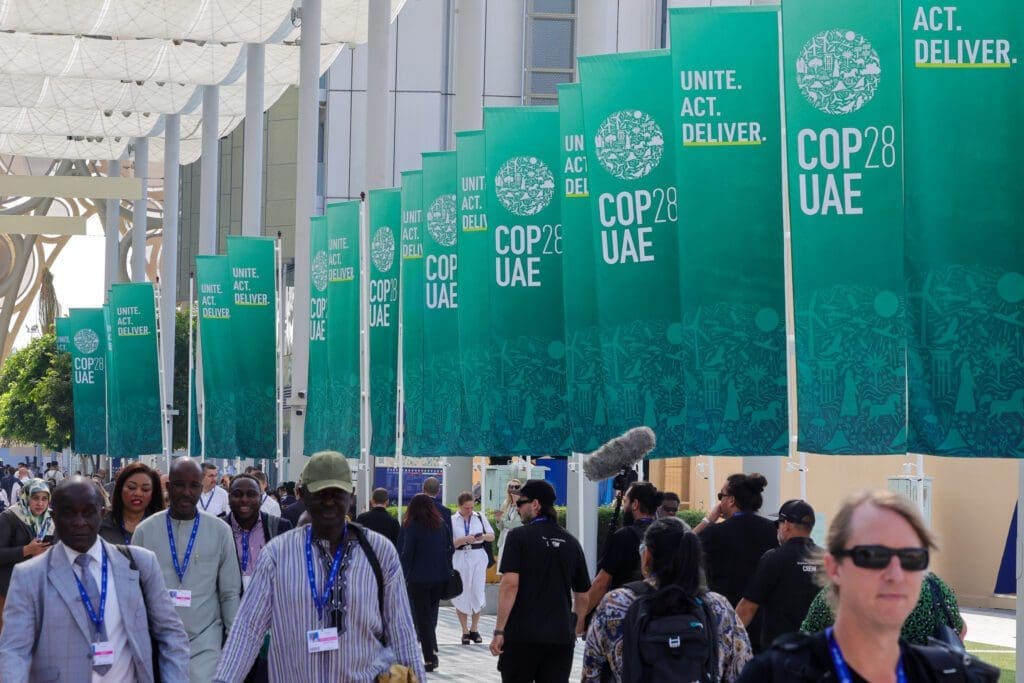For residents of sweltering parts of the Middle East and North Africa, it will come as little surprise that 2023 could be the hottest year on Earth since records began. July has already set a grim landmark as the hottest month on record, prompting United Nations Secretary-General António Guterres to remark that “the era of global boiling has arrived.”
This year’s heatwave is a stark warning for the MENA region, among the driest and hottest on the planet. It is clear that high temperatures rising sea levels, erratic precipitation, drought, and water scarcity are unavoidable. Governments should urgently prioritize mitigating these phenomena, particularly given their potential to exacerbate existing economic, social, and political crises. Rapid population growth, food insecurity, conflict, economic woes, and the resulting population movements will make responding to the climate crisis even more complex, and vice versa.
Yet despite the magnitude of these challenges, state responses across the region have been uneven and inadequate. While the oil-rich countries of the Gulf have more financial clout to tackle the issue, non-oil-exporting countries with fewer resources are doing little or nothing at all, despite being set to suffer the worst impacts of climate change over the coming decades. The region’s governments must therefore leverage November’s COP28 forum to foster greater cooperation on the issue, push the international community to bolster climate resilience, stimulate sustainable economic transformation, and address the multifaceted challenges posed by escalating heat extremes.
Rising Temperatures, Mounting Challenges
The MENA region is among the world’s most vulnerable to climate change, from soaring temperatures to drought and flood cycles, sea-level rises, and scarcity of fresh water. By the end of the century, half of the region’s population could face “super-extreme” weather events, with temperatures exceeding 60°C, turning cities into hotbeds of discomfort and causing crops to fail.
The climate crisis will be particularly devastating for more vulnerable social groups such as older people, women, children, and individuals who work outdoors in the sweltering heat. The urban heat island effect will cause increasing heat-related health problems in cities, set to be home to 68% of the population of Arab countries by 2050.
The region will also be particularly vulnerable to rising sea levels, as most of its economic activity, including agriculture, occurs in coastal areas. Approximately 7% of the region’s population lives less than five meters above sea level, in areas particularly susceptible to flooding, erosion, and soil salinization. Were sea levels to rise by one meter, that would significantly impact low-lying countries in the Gulf and coastal regions of North Africa. Even a half-meter rise would affect 43 MENA port cities, potentially displacing more than two million people in Alexandria, Egypt alone. Qatar, the United Arab Emirates, and Saudi Arabia are planting mangrove trees to protect coastal areas, but most MENA states have not developed comprehensive strategies to deal with rising sea levels. Like other climate measures, they are hobbled by a lack of funding, technical capacity, and political will.
Global warming will also cause acute water shortages in a region home to 14 of the 33 world’s most water-stressed countries. The UN estimates that by 2025, 90% of the region’s population will live in water-scarce countries, where water availability will barely scrape 500 cubic meters per capita per year, the UN’s benchmark for “absolute scarcity.” Countries like Yemen and Iraq, already ravaged by years of violence and other problems, could face conflicts over water. Yemen has an average of just 198 cubic meters of water per capita per year, which is expected to decrease by a third even as its population doubles by 2050. Iraq must deal with overconsumption and potential water conflicts with its neighbors, amid worrying forecasts that the Tigris and Euphrates rivers could dry up by 2040.
These challenges will add to and exacerbate other economic and social challenges facing the region, posing long-term threats to its habitability. The World Bank has estimated that climate change could displace up to 20 million people in the region, compounding existing refugee crises such as those of Sudan, Syria, and Yemen. Climate change has already reduced MENA countries’ Gross Domestic Product by 0.4%, to 1.3% yearly. Some experts estimate GDP could be reduced by an astounding 14% unless serious adaptation measures are put in place.
Too Little, Too Late?
Despite these towering challenges and the need for a more coordinated, region-wide approach, states across the MENA region have done far too little to prepare. While some have taken initial steps by adopting national climate pledges under the Paris Agreement, carbon neutrality commitments, and the Green Grids Initiative, implementation remains insufficient due to a lack of technical resources and funds. The World Bank has estimated that the region needs some $186 billion in climate finance to fulfill these commitments.
Although the cost of action is high, the price of inaction threatens to be much higher. Implementing proactive climate policies could offer numerous opportunities to avoid catastrophe, but failure to do so will exacerbate social inequalities, create political instability, and increase the risk of conflicts over scarce resources.
No area of climate change mitigation is more urgent for the region than water security. While some governments are adopting piecemeal measures as desalination, water management policies, water recycling, and public awareness campaigns to tackle water scarcity, others are hindered by political and economic barriers. Political tensions between Egypt, Sudan, and Ethiopia over the Renaissance Dam have fanned fears of conflict over access to Nile waters, while in Libya water canals have been destroyed due to political tensions. The region’s actors must take urgent, cooperative action, investing in modern technology and optimizing consumption, as well as exerting earnest diplomatic efforts to resolve conflicts over natural resources.
The timeframe for effective climate intervention is swiftly diminishing. As things stand, the Gulf Cooperation Council’s member states are better equipped than other MENA countries to handle the coming crises, due—somewhat ironically—to their hydrocarbon wealth. The Gulf monarchies will be able to employ air conditioning to protect their populations from heatwaves, but in the long term, they are expected to face fiscal constraints due to the transition to more climate-friendly fuels. Conversely, poorer nations are left with no viable solutions. A case in point is Yemen, where conflict has already crippled social protection systems. This disparity between these close neighbors reveals a critical absence of region-wide climate adaptation policies, despite individual countries having laws on sustainable development.
One rare sign of hope is that civil society actors across the MENA region are increasingly recognizing the severity of the situation and their shared responsibility to address the region’s unique climate vulnerabilities. From academic institutions to NGOs and climate activists, businesses and media, various stakeholders are mobilizing the younger generation, fostering awareness, and pushing states to adopt sustainable policies. Institutes such as the Gulf Organisation for Research & Development (GORD), along with environmental civil society groups such as the Arab Youth Climate Movement in Qatar and IndyACT in Lebanon, are pushing advocacy, awareness, and research forward. Such efforts need to be further coordinated and synthesized, to foster innovative climate solutions and push environmental issues up the agenda.
It is perhaps symbolic that the COP28 climate conference is hosted by the UAE after the country recorded temperatures above 50°C for the first time. The conference presents an opportunity to build a global coalition to bolster climate resilience and push the climate adaptation agenda forward. COP28 should be a forum for championing energy efficiency and pushing for climate-resilient building standards, pushing for green spaces to mitigate urban heat islands, and fostering knowledge-sharing and the transfer of climate technology.
As temperatures soar, better policies to mitigate devastating global warming are more necessary than ever. Nowhere is this more true than in the MENA region.
The opinions expressed in this article are those of the author and do not necessarily reflect the views of the Middle East Council on Global Affairs.


